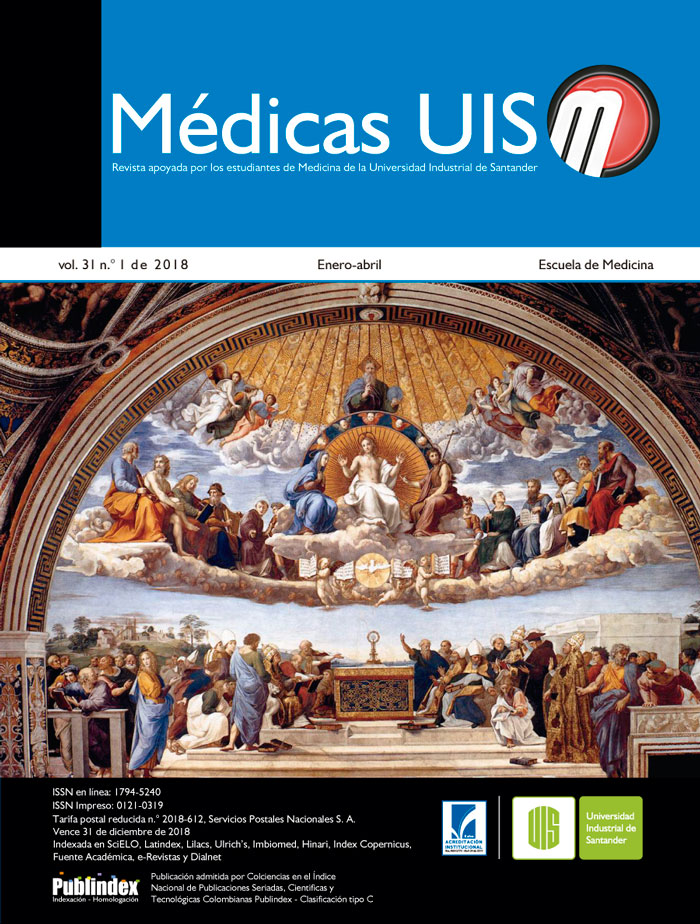Abstract
Introduction: hydatidiform mole is the most common form of gestational trophoblastic disease. The quantification of serum beta-hCG
has important value in its diagnosis and prognosis, however in Colombia there are no references of its values according to the type of
mole or risk factors. Objective: to study the behavior of beta-hCG values according to the type of mole and the risk factors. Materials
and Methods: 74 cases with diagnosis of hydatidiform mole were studied in the pathology department of the Industrial University of
Santander between 2005 and 2014. It was recorded from the data provided by the clinical history: smoking habit, blood sample, indication
of the EMA-CO regimen, sociodemographic and gyneco-obstetric antecedents and the beta-hCG concentration prior to the evacuation
treatment. Results: 63 cases presented valid measurements of beta-hCG. In the analysis nonparametric tests with a level of significance of
10% were used. The median beta-hCG for complete and partial mole was 270 852 IU / L and 40 379 IU / L respectively. There was a significant
difference for beta-hCG values between mola groups (p <0.0001). For the diagnosis of complete mole, a cut-off point of 170,000 U / L
showed a sensitivity of 91.5% and a specificity of 75%. The EMA-CO indication showed a significant association with beta-hCG values (p =
0.066); associations with smoking (p = 0.118) and multiparity (p = 0.111) were not significant. Conclusion: the quantification of beta-hCG
helps to classify the type of mole although its diagnostic performance is modest. MÉD.UIS. 2018;31(1):39-46.
References
Medunab. 2008; 11(2):140-8.
2. Stevens FT, Katzorke N, Tempfer C, Kreimer U, Bizjak G, Fleisch
MC, Fehm Gestacional trophoblastic disorders: An update in
2015. Geburtsh Frauenheilk. 2015;75:1043-50.
3. Ezpeleta M, López A. Enfermedad trofoblástica gestacional.
Aspectos clínicos y morfológicos. Rev Esp Patol. 2002;35(2):187-
200.
4. Cortés C, Ching R, Páez P, Rodríguez A, León H, Capasso
S, et al. La mola hidatiforme: un indicador de la situación
sociodemográfica en salud sexual y reproductiva. Informe
quincenal Epidemiológico Nacional. 2003;8(12):199-204.
5. Altieri A, Franceschi S, Ferlay J, Smith J, La Vecchia C.
Epidemiology and aetiology of gestational trophoblastic diseases.
The Lancet. Oncology. 2003;4(11):670-8.
6. Ramírez JA, Orozco LC, Agudelo M. Mola hidatidiforme: Validez
del Diagnóstico Clínico. Salud UIS. 2000;32(1):27-29.
7. International Agency for Research on Cancer; World Health
Organization; International Academy of Pathology. Pathology and
Genetics of Tumours of the Breast and Female Genital Organs.
Lyon: IARC Press; 2003.
8. Parazzini F, La Vecchia C, Franceschi S, Pampallona S, Decarli A,
Mangili G, Belloni C. ABO blood-groups and the risk of gestational
trophoblastic disease. Tumori. 1985 Apr 30;71(2):123-6.
9. Sasaki K, Hata H, Nakano R. ABO blood group in patients
with malignant trophoblastic disease. Gynecol Obstet Invest.
1985;20(1):23-6.
10. La Vecchia C, Franceschi S, Parazzini F, Fasoli M, Decarli A,
Gallus G, Tognoni G. Risk factors for gestational trophoblastic
disease in Italy. Am J Epidemiol. 1985 Mar;121(3):457-64.
11. Parazzini F, La Vecchia C, Mangili G, Caminiti C, Negri E,
Cecchetti G, Fasoli M. Dietary factors and risk of trophoblastic
disease. Am J Obstet Gynecol. 1988 Jan;158(1):93-9.
12. Berkowitz RS, Goldstein DP. Current advances in the management
of gestational trophoblastic disease. Gynecol Oncol. 2013
Jan;128(1):3-5.
13. Berkowitz RS, Ozturk M, Goldstein DP, Bernstein MR, Hill L and
Wands JR. Human chorionic gonadotropin and free subunits
serum levels in patients with partial and complete hydatidiform
moles. Obstet Gynecol. 1989 Aug;74(2):212–6.
14. Berkowitz RS, Goldstein DP. Presentation and management of
molar pregnancy. In: Hancock BW, Newlands ES, Berkowitz RS.
Gestational trophoblastic disease. London: Chapman and Hall;
1997. p. 127-142.
15. Goldstein DP, Berkowitz RS, Bernstein MR. Management of
complete molar pregnancy. J Reprod Med. 1987 Sep; 32(9):634-9.
16. Genest DR, Laborde O, Berkowitz RS, Goldstein DP, Bernstein
MR, Lage J. A clinicopathologic study of 153 cases of complete
hydatidiform mole (1980-1990): histologic grade lacks prognostic
significance. Obstet Gynecol 1991 Sep;78(3 Pt 1):402-9.
17. Schlaert JB, Morrow CP, Kletzky OA, Nalick RH, D’Ablaing
GA. Prognostic characteristics of serum human chorionic
gonadotropin titer regression following molar pregnancy. Obstet
Gynecol. 1981 Oct;58(4):478-82.
18. Berkowitz RS, Goldstein DP, Bernstein MR. Natural history of
partial molar pregnancy. Obstet Gynecol. 1985;66(5):677-81.
19. Szulman AE, Surti U. The clinicopathologic profile of the partial
hydatidiform mole. Obstet Gynecol. 1982;59(5):597-602.
20. Maestá I, Rudge MVC, Passos JRS., Calderon IMP, Carvalho
NR, Consonni M. Características das curvas de regressão da
gonadotrofina coriônica pós-mola hidatiforme completa. Rev
Bras Ginecol Obstet. 2000;22(6):373-80.
21. Van Trommel NE, Sweep F, Schijf C, Messuger L, Thomas, C.
Diagnosis of hydatidiform mole and persistent trophoblastic
disease: diagnostic accuracy of total human chorionic
gonadotropin (hCG), free hCGa- and b-subunits, and their ratios.
Eur J Endocrinol. 2005;153(4):565–75.
22. Soto-wright V, Bernstein M, Goldstein DP, Berkowitz RS. The
changing clinical presentation of complete molar pregnancy.
Obstet Gynecol 1995;86(5):775-9.
23. Korevaar TI, Steegers EA, de Rijke YB, Visser WE, Hofman A,
Jaddoe VW, et al. Reference ranges and determinants of total
hCG levels during pregnancy: the Generation R Study. Eur J
Epidemiol. 2015;30(9):1057–1066.
24. Tiezzi DG, Andrade JM, Reis FJC, Lombardi W, Marana HRC.
Fatores de risco para doença trofoblástica gestacional persistente.
Rev Bras Ginecol Obstet. 2005;27(6):331-9.

This work is licensed under a Creative Commons Attribution 4.0 International License.
Copyright (c) 2018 Revista Médicas UIS
